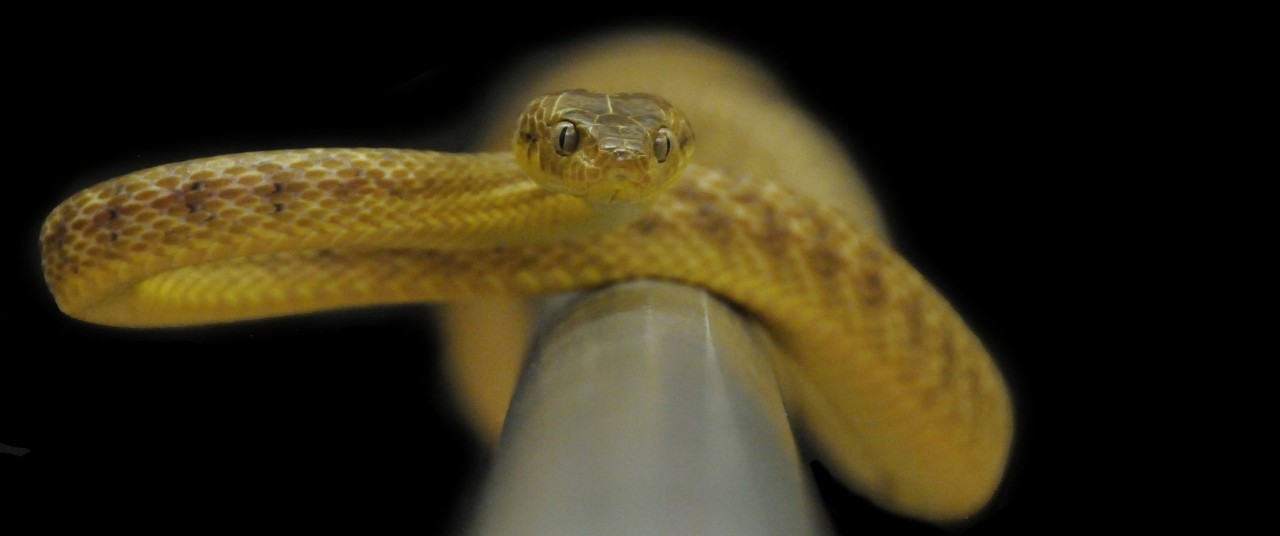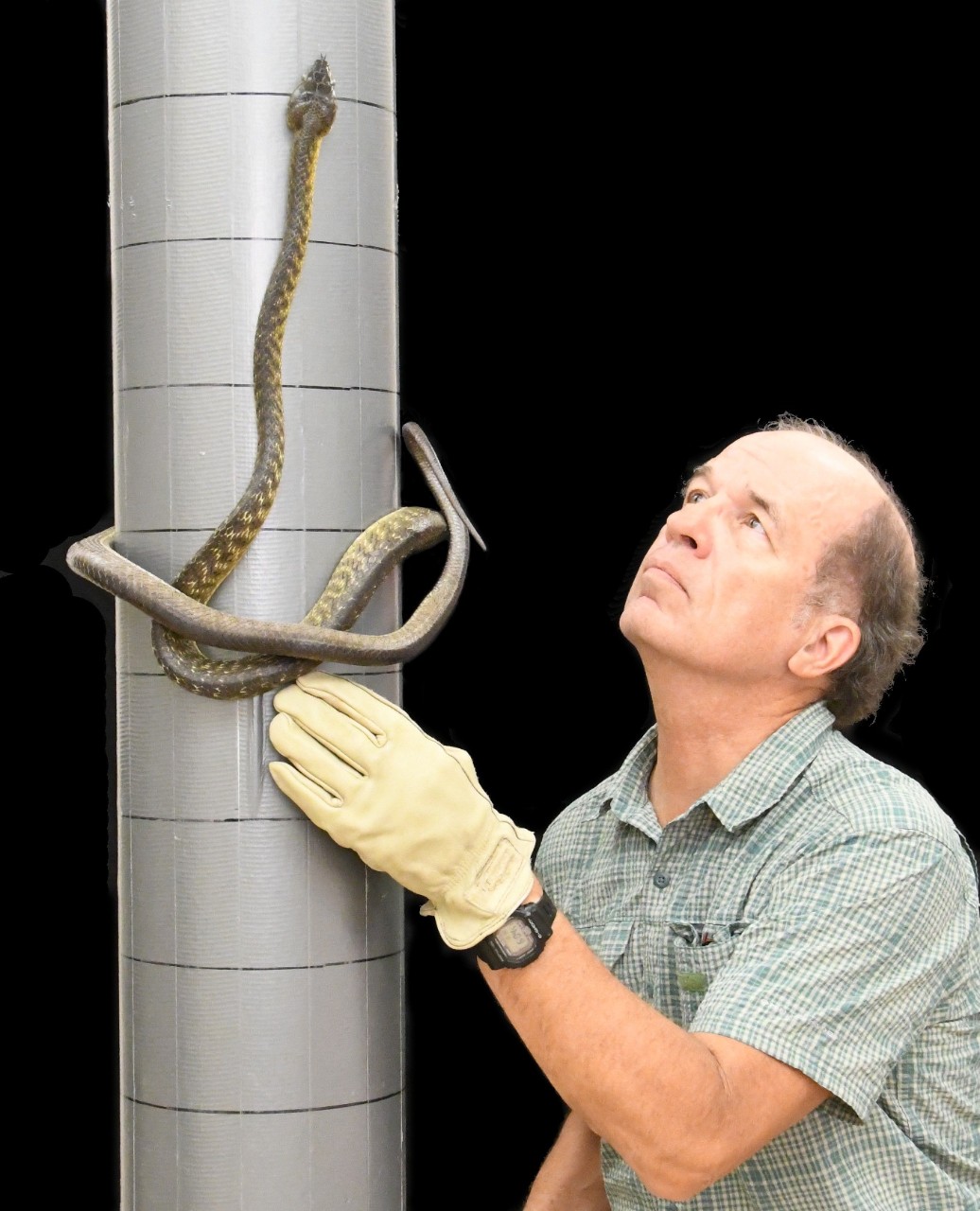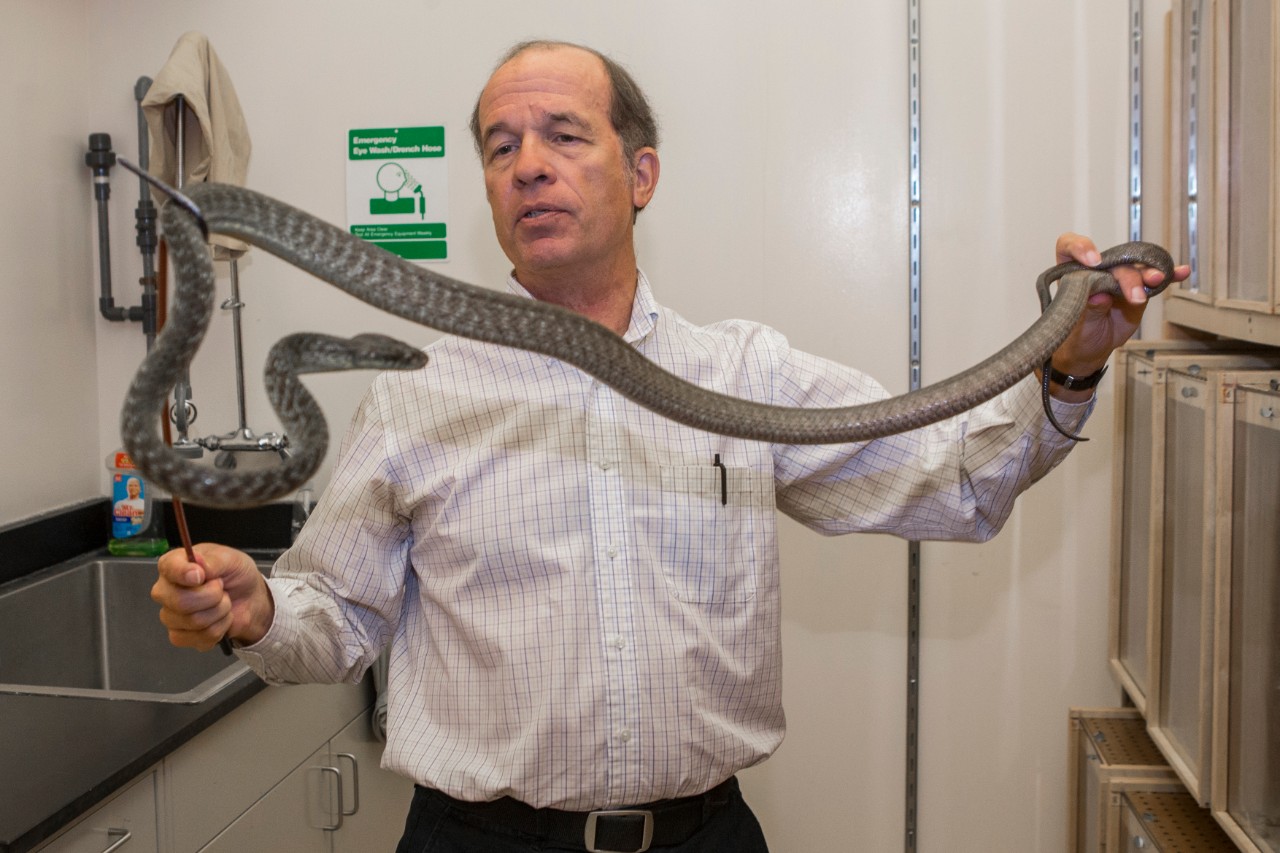
Biologists discover bizarre 'lasso' snake locomotion
UC biologist helps decipher a type of snake movement new to science
University of Cincinnati biologist Bruce Jayne has spent his career studying the superpowers of snakes, which can move easily through water, in burrows, over sand and in the treetops.
Now add one more.
Jayne and his collaborators from Colorado State University discovered a new mode of snake locomotion that allows nimble brown tree snakes to climb wide cylinders by wrapping their bodies around them. It’s unlike any other known snake behavior.
This lasso locomotion, named because of a lasso-like body posture, may contribute to the success and impact of this highly invasive species. It allows these animals to reach prey that might be otherwise unobtainable and may also explain how this species could climb power poles, leading to electrical outages.
Researchers said they hope the findings will help protect endangered birds from the snakes by leading to more effective barriers to nest boxes.
The study was published Jan. 11 in the journal Current Biology.
Ways snakes move
For the past century, snake locomotion traditionally has been categorized into four modes: rectilinear, lateral undulation, sidewinding and concertina. Jayne has helped describe these modes in detail in his biology lab in UC’s College of Arts and Sciences.
This new discovery of a fifth mode was the unexpected result of a project led by CSU emeritus professor Julie Savidge aimed at protecting the nests of Micronesia starlings, one of only two native forest species still remaining on Guam.

UC biology professor Bruce Jayne attempts to get a brown tree snake to climb a wide cylinder using lasso locomotion. He and researchers from CSU described this behavior for the first time. Photo/Bruce Jayne
The brown tree snake has decimated forest bird populations on Guam, where the new snake locomotion discovery took place. The snake, which is nocturnal, was introduced to Guam in the late 1940s or early 1950s. Shortly thereafter, bird populations started to decline.
Savidge, the study’s lead author, conducted research on Guam in the 1980s and pinpointed the snake as the culprit for the loss of birds. The reptile has caused extensive damage and is responsible for numerous power outages across the island each year.
“Most of the native forest birds are gone on Guam,” Savidge said. “There’s a relatively small population of Micronesian starlings and another cave-nesting bird that has survived in small numbers. The starling serves an important ecological function by dispersing fruit and seeds which can help maintain Guam’s forests.”
CSU’s Thomas Seibert, co-author and emeritus faculty, said the team was attempting to use a three-foot-long metal baffle to keep the brown tree snakes from climbing up to bird boxes. These same baffles have been used to keep other snakes and raccoons away from nest boxes in the yards of bird-watchers. But this new study suggests the barriers might pose little obstacle to brown tree snakes.
It was a shocker. Nothing I'd ever seen compares to it.
Thomas Seibert, CSU biologist on discovery of new snake locomotion
“We didn’t expect that the brown tree snake would be able to find a way around the baffle,” he said. “Initially, the baffle did work, for the most part. We had watched about four hours of video and then all of a sudden, we saw this snake form what looked like a lasso around the cylinder and wiggle its body up.”
Seibert said that he and CSU biologist Martin Kastner almost fell out of their chairs when they first observed this new form of locomotion.
“We watched that part of the video about 15 times,” Seibert said. “It was a shocker. Nothing I’d ever seen compares to it.”
To confirm the discovery, the team subsequently reached out to UC’s Jayne, an expert on different aspects of locomotion and muscle function, especially in snakes. Brown tree snakes are champion climbers, said Jayne, a study co-author.
“Brown tree snakes are especially good at getting almost anywhere,” Jayne said. “It’s impressive. They can climb vertically using even the tiniest projections on a surface, and they can bridge enormous gaps in the tree canopy. They can push themselves up vertically more than two-thirds of their body length.”
Jayne said snakes typically climb steep, smooth branches or pipes using a movement called concertina locomotion in which the snake bends sideways to grip at least two regions.
But with lasso locomotion, the snake uses the loop of the lasso to form a single gripping region.
CSU’s Seibert returned to Guam to record high-resolution video of this new climbing method so that Jayne could better interpret the snakes’ movements.
“It wasn’t obvious how they were able to climb a cylinder,” Jayne said. “The snake has these little bends within the loop of the lasso that allow it to advance upwards by shifting the location of each bend.”
Lasso locomotion is more physically demanding than other climbing methods, Jayne said.
“Even though they can climb using this mode, it is pushing them to the limits. The snakes pause for prolonged periods to rest,” he said.
Savidge said the discovery of a new mode of snake locomotion is exciting. A self-described ecologist, the scientist said she has worked with brown tree snakes for more than 30 years.
“Hopefully what we found will help to restore starlings and other endangered birds, since we can now potentially design baffles that the snakes can’t defeat,” she said. “It’s still a pretty complex problem.”
Jayne said what the team discovered shows how amazing brown tree snakes are.
“I’ve been working on snake locomotion for 40 years and here, we’ve found a completely new way of moving,” he said. “Odds are, there is more out there to discover.”
Featured image at top: Researchers from the University of Cincinnati and Colorado State University described a new type of snake locomotion by nimble brown tree snakes. Photo/Bruce Jayne
More Amazing Animals
Watch more amazing animal behavior videos from UC biology professor Bruce Jayne's lab.

UC biology professor Bruce Jayne holds a brown tree snake in his lab. Photo/Joseph Fuqua II/UC Creative + Brand
Impact Lives Here
The University of Cincinnati is leading public urban universities into a new era of innovation and impact. Our faculty, staff and students are saving lives, changing outcomes and bending the future in our city's direction. Next Lives Here.
Stay up on all UC's COVID-19 stories, read more #UCtheGood content, or take a UC virtual visit and begin picturing yourself at an institution that inspires incredible stories.
Related Stories
UC celebrates record spring class of 2025
May 2, 2025
UC recognized a record spring class of 2025 at commencement at Fifth Third Arena.
UC students recognized for achievement in real-world learning
May 1, 2025
Three undergraduate University of Cincinnati Arts and Sciences students are honored for outstanding achievement in cooperative education at the close of the 2024-2025 school year.
‘Doing Good Together’ course gains recognition
May 1, 2025
New honors course, titled “Doing Good Together,” teaches students about philanthropy with a class project that distributes real funds to UC-affiliated nonprofits. Course sparked UC’s membership in national consortium, Philanthropy Lab.
